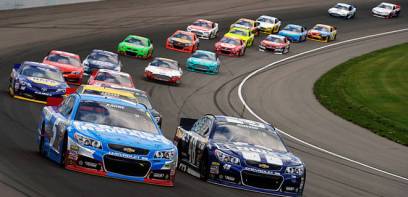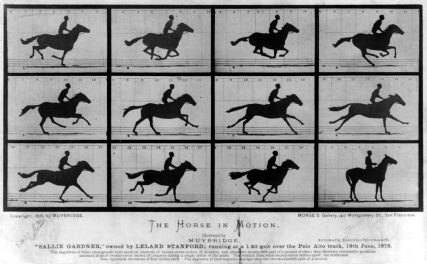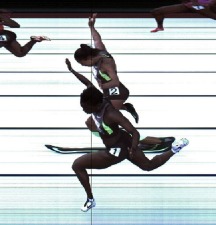Seeing Action

NASCAR drivers race by in Wilmington, Delaware.
In this section of the course, we will be examining the nature of seeing action or motion, in regards to the use of still and moving images, and videos. This week, students will explore the variety of ways to see action as it is occurring, and the different perspectives each aspect brings. The way one views an incident can greatly impact how he or she interprets the situation, and in this section, students will discover just how different one moment can look depending on the point of view.
Everything we do throughout the course of a 24- hour span requires movement and action. But what is actually occurring and what we think we are seeing can be completely different courses of action. How can we examine this difference? How is an individual supposed to recognize whether they have a skewed point of view on the motion that is occurring? This section will help students to recognize these differences, and to look at their surroundings from literal different points of view. Whether it is an occurrence they see on their way to class, or a sporting event that they are attending or watching on television, students will learn to see action from other standpoints that may not normally be recognized. This will help with forming a better understanding of what is occurring, and having the ability to capture the motions around an individual without jumping to conclusions.
The Aspects of Seeing Action
There are several different factors that play a part in how one views action. One of these factors is the difference between still and moving images. A still picture of an object in motion can open the eyes of the audience to see much more than their first impression. On the contrary, moving images paint a bigger picture for the viewer to see the broader outcome of the action that is taking place, not just one moment in time. In order to grasp the true meaning of an action, we will be taking a look at both the still images and moving images of several incidents regarding a variety of topics. In addition to the still and moving images, students will also be taking a look at the different types of moving images. For example, seeing something at full speed can greatly differ from what is seen when shown in slow motion. In this section, we will be taking a look at all of these factors in seeing action.
This section of the course will focus on three events in history, and how still and moving images help define these events and how people view them. The three events studied will be Eadweard Muybridge’s “Horse in Motion,” the civil war occurring in Syria, and the 2012 United States Olympic Track and Field qualifying race between Jeneba Tarmoh and Allyson Felix. These three events were chosen in order to show the various ways that seeing action can be viewed. Muybridge’s “Horse in Motion” brings a historical aspect to moving images, while the Olympic trials show how it affects sports. The Syrian video and photographs will help depict the citizen journalism nature of seeing action, and will help determine which type of photography has a greater emotional impact on its viewers.
Eadweard Muybridge’s “Horse in Motion”
In 1886, Eadweard Muybridge revolutionized the way we see and capture movement. Hired buy a wealthy horse owner, Muybridge’s job was to photograph a horse’s gallop while it ran around the track, in order to capture the different phases of its gallop. After years of failure, Muybridge hit a breakthrough in 1886. He was able to set up a row of cameras that captured the horse as it galloped across, demonstrating phases by split seconds of the horse as it ran. These photographs became famous for being the first to ever capture motion in such a manner, revolutionizing the way we use motion photography today. The pictures exemplified that what we see in action may not be what is actually occurring. When watching a horse run, an individual would never notice that at one point, all four of the horses legs are in the air. Muybridge’s photographs show that the horse is indeed in the air for a split second, showing the world that still photographs of action can bring about a point of view never seen before.2012 United States Olympic Track and Field Trials
The above video is footage of the women’s 100-meter dash at the 2012 U.S. Olympic track and field trials [2]. One of the most controversial sports topics in recent years; this event exemplifies the many different aspects of viewing a sport, and all of the results that are shown from it. The clip shows the race ending with two athletes, Allyson Felix and Jeneba Tarmoh, seemingly tying for third place. When watched at normal speed, it is difficult to tell a difference in the results, but what sets this event apart from all others is how the use of replay could not even provide an answer.
The image to the right shows what many believe to be the true result of the race.
At first glance, it looks as if the runners are crossing the line at the same exact time. However, Allyson Felix’s left shoe seems to be distorted due to the time lapse of the photograph. Although it seems as if her shoe crossed the line first, this photograph was ruled to be undeterminable. Instead, the decision was made by a coin flip.
This example will help students obtain a better understanding of why slow motion is used, as well as still photography even for the fastest of sprinters. Students will then be asked to watch the video at regular speed, slow motion, and view the photograph and interpret their results from what they have seen.
#chicagogirl: Citizen Journalism and the Crisis in Syria
While still photography and slow motion videos are essential to analyzing and critiquing actions, they are also essential for providing information to users about important events worldwide. Such is the case with the YouTube video posted by “#chicagogirl”[4]. The video is of a young, Middle Eastern woman from Chicago that captured videos of the crisis going on in Syria. Her footage shows explosions and other attacks that occur throughout the streets of the country for the viewers who watch. Students will watch this video and then proceed to view the pictures from the AFP site of the hospitals in Syria (http://blogs.afp.com/correspondent/?post/syria-s-hospital-of-horrors) [5]. This section of the course will focus more on the impact of pictures and videos of action that is occurring, rather than the different perspectives provided by footage. After watching the video and viewing the photographers, students will be asked to describe the emotions they felt from both, and which type of photography impacted them in a greater way. It is important for both viewers and journalists to understand what type of photography will get the message across, or important for understand what type of message they are trying to send.
Other Related Topics:
- See Data and Technology
- Seeing Is Blindness
- Seeing Differently
Works Cited
[1] Horse in Motion, Eadweard Muybridge, ca. 1886. (n.d.). Retrieved March 23, 2015, from http://www.hrc.utexas.edu/exhibitions/permanent/windows/southeast/eadweard_muybridge.html
[2] 2012 U.S. Olympic Trials: Women’s 100m final [Motion picture]. (2012). United States: YouTube.
[3] Borden, S. (2012, June 24). A Photo Finish Too Close to Call, Even by Camera. Retrieved March 23, 2015, from http://www.nytimes.com/2012/06/25/sports/olympics/2012-olympics-allyson-felix-and-jeneba-tarmoh-100-meter.html?_r=0
[4] #chicagogirl .(2014). United States: Youtube.
[5] Doumany, A. (2104, November 12). Syria’s ‘hospital’ of horrors. Retrieved March 23, 2105, from http://blogs.afp.com/correspondent/?post/syria-s-hospital-of-horrors
Additional Resources
1. Aldrin, B., & David, L. (2013). Mission to Mars: My Vision for Space Exploration. Washington, D.C.: National Geographic.
Astronaut Buzz Aldrin’s autobiography provides an incredibly rare point of view of space travel, and the United States’ successful of landing men on the moon. Along with Neil Armstrong, Aldrin was the first astronaut to step foot on the moon. What makes this book so unique is that it is written in the first person perspective of the man who actually lived it, not a spectator watching on television. Aldrin not only recounts his experience of going to the moon, he engages the reader in an idea of going beyond that, as the title suggests. As someone who has experienced what it is like to be beyond Earth, Aldrin discusses the possibilities of continuing space travel past the moon, and to develop more programs to accomplish such a feat.
2. Borst, A., & Euler, T. (2011). Seeing Things in Motion: Models, Circuits, Mechanisms. Neuron,71(7), 974-994
This journal entry by Alexander Borst and Thomas Euler contains insight as to why humans have an innate ability to see action clearly. While many debates regarding seeing action revolve around humans’ ability to accurately see motion as opposed to a camera angle, Borst and Euler write about why we are able to see motion so well. Incorporating both everyday life with scientific history and data, the two authors help explain the important concept of recognizing motion, an everyday aspect of life that often gets overlooked.
3. Burr, D., & Ross, J. (1986). Visual Processing of Motion. Trends in Neurosciences, 9, 304-307.
This journal written in collaboration by David Burr and John Ross discusses the science behind our ability to see motion versus what a camera can pick up. Against popular belief, Burr and Ross explain that the naked eye is better at picking up motion rather than a camera. The two authors argue that when view a fast-paced motion, the eye sees this as one smooth action, while a camera is actually blurred images moving quickly together to form a solid image. While cameras can provide angles and slow motion that would otherwise be impossible to see, it cannot provide the true smooth quality of what the naked eye provides.
4. Hoerl, C. (2012). Seeing Motion and Apparent Motion. European Journal of Philosophy, 10, 1-20.
Christoph Hoerl is a German scholar who conducted experiments in order to determine how people see real motion versus apparent motion. In this reading, Hoerl discusses the results of his experiments where he had participants view stationary objects in different environments, and see if they detected any motion in the objects. Hoerl writes about these results, and discusses why people may see motion when in fact there is no motion present, and the science behind people’s ability to see action.
5. Launius, R. (2014). Hubble’s Legacy: Reflections by Those Who Dreamed it, Built it, and Observed the Universe with it. Washington, D.C.: Smithsonian Institution Scholarly Press.
This book, edited by Roger Launius, contains a variety of different voices, including the scientists behind the Hubble Telescope, historians of science who have studied the history of the telescope, and astronauts involved in its observations. Written as both an informational piece as well as historical, this book provides the history of the telescope in addition to its impact on space knowledge and the results found from its observations. The findings mention in this reading discuss what the Hubble Telescope has meant to science in terms of the size of space around us, and the movement of the stars and galaxies surrounding us in the universe.
6. Neufeld, M. (2013). Spacefarers: Images of Astronauts and Cosmonauts in the Heroic Era of Spaceflight. Washington, D.C.: Smithsonian Institution Scholarly Press.
This book, written by Michael Neufeld, provides a fresh aspect of space travel. Rather than writing from a historical approach, the book focuses on those who are responsible for the success of space flight, including the astronauts and engineers behind the products. The context also includes the media’s role in space flight throughout the 1960s and 70s, as well as the way the American community viewed those involved with space travel. Unique from a typical book of historical aspects, Neufeld is able to exhibit the way this era affect American society as a whole, and those who drove the movement of spaceflight.
7. Rinard, J. (2007). Book of Flight (Rev. ed.). Buffalo, NY: Firefly Books.
Judith Rinard’s literature focuses on the act of flight from a historical aspect. Using historical pieces of evidence as well as photographs and illustrations, Rinard educates her readers by writing about specific events in history that helped develop flight the way it is today. Such incidents include the Wright brothers’ experiments, the Hindenburg disaster, as well as the Apollo missions to the moon. The book is put into chronological order for readers to gain a greater understanding of how aviation has become so relevant in today’s travel. Written in the third person, Rinard is able to provide a well-written historical book for students to enjoy.
Photo Credit:
[1] NASCAR- Fox 40: https://tribfox40.files.wordpress.com/2015/02/081513-nascar-kasey-kahne-la-pi_20130816011329448_660_320.jpg
[2] “Horse in Motion”- Imaging Resource: http://www.imaging-resource.com/ee_uploads/news/1284/muybridge-9.jpg
[3] Track and Field — New York Times: http://www.nytimes.com/2012/06/25/sports/olympics/2012-olympics-allyson-felix-and-jeneba-tarmoh-100-meter.html?_r=1
Chet Palumbo

